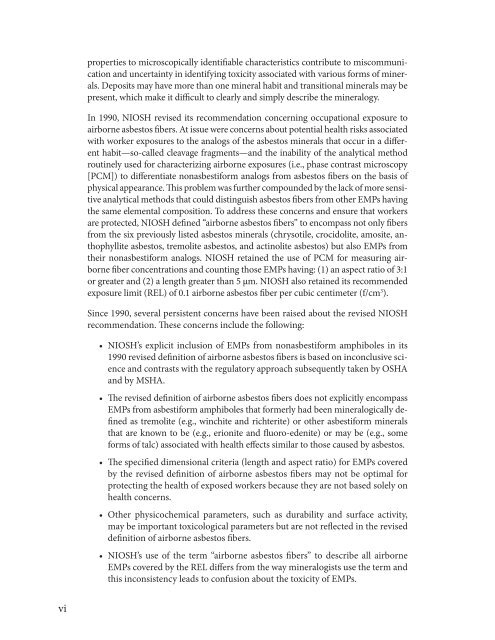Asbestos Fibers and Other Elongate Mineral Particles: State of the ...
Asbestos Fibers and Other Elongate Mineral Particles: State of the ...
Asbestos Fibers and Other Elongate Mineral Particles: State of the ...
- No tags were found...
You also want an ePaper? Increase the reach of your titles
YUMPU automatically turns print PDFs into web optimized ePapers that Google loves.
vi<br />
properties to microscopically identifiable characteristics contribute to miscommunication<br />
<strong>and</strong> uncertainty in identifying toxicity associated with various forms <strong>of</strong> minerals.<br />
Deposits may have more than one mineral habit <strong>and</strong> transitional minerals may be<br />
present, which make it difficult to clearly <strong>and</strong> simply describe <strong>the</strong> mineralogy.<br />
In 1990, NIOSH revised its recommendation concerning occupational exposure to<br />
airborne asbestos fibers. At issue were concerns about potential health risks associated<br />
with worker exposures to <strong>the</strong> analogs <strong>of</strong> <strong>the</strong> asbestos minerals that occur in a different<br />
habit—so-called cleavage fragments—<strong>and</strong> <strong>the</strong> inability <strong>of</strong> <strong>the</strong> analytical method<br />
routinely used for characterizing airborne exposures (i.e., phase contrast microscopy<br />
[PCM]) to differentiate nonasbestiform analogs from asbestos fibers on <strong>the</strong> basis <strong>of</strong><br />
physical appearance. This problem was fur<strong>the</strong>r compounded by <strong>the</strong> lack <strong>of</strong> more sensitive<br />
analytical methods that could distinguish asbestos fibers from o<strong>the</strong>r EMPs having<br />
<strong>the</strong> same elemental composition. To address <strong>the</strong>se concerns <strong>and</strong> ensure that workers<br />
are protected, NIOSH defined “airborne asbestos fibers” to encompass not only fibers<br />
from <strong>the</strong> six previously listed asbestos minerals (chrysotile, crocidolite, amosite, anthophyllite<br />
asbestos, tremolite asbestos, <strong>and</strong> actinolite asbestos) but also EMPs from<br />
<strong>the</strong>ir nonasbestiform analogs. NIOSH retained <strong>the</strong> use <strong>of</strong> PCM for measuring airborne<br />
fiber concentrations <strong>and</strong> counting those EMPs having: (1) an aspect ratio <strong>of</strong> 3:1<br />
or greater <strong>and</strong> (2) a length greater than 5 µm. NIOSH also retained its recommended<br />
exposure limit (REL) <strong>of</strong> 0.1 airborne asbestos fiber per cubic centimeter (f/cm 3 ).<br />
Since 1990, several persistent concerns have been raised about <strong>the</strong> revised NIOSH<br />
recommendation. These concerns include <strong>the</strong> following:<br />
• NIOSH’s explicit inclusion <strong>of</strong> EMPs from nonasbestiform amphiboles in its<br />
1990 revised definition <strong>of</strong> airborne asbestos fibers is based on inconclusive science<br />
<strong>and</strong> contrasts with <strong>the</strong> regulatory approach subsequently taken by OSHA<br />
<strong>and</strong> by MSHA.<br />
• The revised definition <strong>of</strong> airborne asbestos fibers does not explicitly encompass<br />
EMPs from asbestiform amphiboles that formerly had been mineralogically defined<br />
as tremolite (e.g., winchite <strong>and</strong> richterite) or o<strong>the</strong>r asbestiform minerals<br />
that are known to be (e.g., erionite <strong>and</strong> fluoro-edenite) or may be (e.g., some<br />
forms <strong>of</strong> talc) associated with health effects similar to those caused by asbestos.<br />
• The specified dimensional criteria (length <strong>and</strong> aspect ratio) for EMPs covered<br />
by <strong>the</strong> revised definition <strong>of</strong> airborne asbestos fibers may not be optimal for<br />
protecting <strong>the</strong> health <strong>of</strong> exposed workers because <strong>the</strong>y are not based solely on<br />
health concerns.<br />
• <strong>O<strong>the</strong>r</strong> physicochemical parameters, such as durability <strong>and</strong> surface activity,<br />
may be important toxicological parameters but are not reflected in <strong>the</strong> revised<br />
definition <strong>of</strong> airborne asbestos fibers.<br />
• NIOSH’s use <strong>of</strong> <strong>the</strong> term “airborne asbestos fibers” to describe all airborne<br />
EMPs covered by <strong>the</strong> REL differs from <strong>the</strong> way mineralogists use <strong>the</strong> term <strong>and</strong><br />
this inconsistency leads to confusion about <strong>the</strong> toxicity <strong>of</strong> EMPs.

















